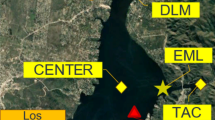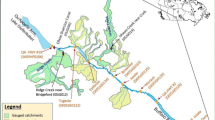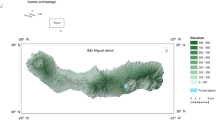Abstract
The Enxoé Reservoir was built in 1998. Since 2000, it has exhibited frequent high chlorophyll-a concentrations, reaching a geometric mean three times higher than the national limit for eutrophication, presenting the reservoir with the highest eutrophic state in Portugal. Toxic algal blooms have also often been observed, which pose serious challenges to water managers, as the reservoir is used for potable water production (25,000 inhabitants). The objective of this study was to implement a reservoir model (CE-QUAL-W2), with inputs from a watershed model (SWAT), in order to represent the actual reservoir state and to test management measures to reduce its trophic level and algal bloom concentration peaks. The integrated model was used to depict the origin of its trophic status. Simulations were also compared to measured data at the reservoir surface (water level, nitrate, orthophosphate, suspended solids, and oxygen) and in water profiles (temperature, oxygen). The model was able to represent stratification and thermocline depths, as well as the actual chlorophyll-a and dissolved oxygen concentrations. The model results showed that internal phosphorus load from deposited sediments was an important factor in fuelling the algal blooms. This process occurs predominantly in summer, when stratification takes place and aeration is reduced, promoting anoxic conditions in the bottom waters. Since the reservoir is relatively shallow (average 5 m), released phosphorus is then easily able to reach the photic zone in most parts of the reservoir, where it is consumed. Different management scenarios were tested, suggesting that a mesotrophic level could barely be reached and maintained simply by reducing the nutrient loads (both external and internal). It is suggested that only an increase in the reservoir dam height could produce a mesotrophic level, averting anoxia by blocking the release of phosphorus from sediments to the photic zone. Future work should focus on a cost–benefit analysis to test the feasibility of each of the proposed scenarios, taking advantage of the integration strategy to assess where in the watershed load reductions would be most effective.










Similar content being viewed by others
Notes
The Portuguese trophic level classification was chosen, adapted from Organisation for Economic Co-operation and Development (OECD). The geometric average is used to reduce the weight of extreme values.
References
APA (2017) Analytical techniques for water quality parameters, ARH-Alentejo laboratories. 2017. From http://apambiente.pt/_zdata/LRA/Parametros_Metodos_ARHALT_Site_2017.pdf. Accessed Aug 2017. In Portuguese
Brito D, Neves R, Branco MA, Prazeres Â, Rodrigues S, Gonçalves MC, Ramos TB (2017a) Assessing water and nutrient long-term dynamics and loads to an eutrophic reservoir in the Enxoé temporary river basin, southeast Portugal. Appl Water Sci (In review)
Brito D, Neves R, Branco MA, Gonçalves MC, Ramos TB (2017b) Modeling flood dynamics in a temporary river basin draining to an eutrophic reservoir in southeast Portugal. Environ Earth Sci 76:377
Butenschön M, Clark J, Aldridge JN, Allen JI, Artioli Y, Blackford J, Bruggeman J, Cazenave P, Ciavatta S, Kay S, Lessin G, van Leeuwen S, van der Molen J, de Mora L, Polimene L, Sailley S, Stephens N, Torres R (2016) ERSEM 15.06: a generic model for marine biogeochemistry and the ecosystem dynamics of the lower trophic levels. Geosci Model Dev 9:1293–1339
Coelho H, Silva A, Chambel-Leitão P, Obermann M (2008) On the origin of cyanobacteria blooms in the Enxoé reservoir. In: 13th world water congress, international water resources association, Montpellier, France
Cole TM, Wells SA (2011) CE-QUAL-W2: a two-dimensional, laterally averaged, hydrodynamic and water quality model, Version 3.71. User manual. U.S. Army Corps of Engineers, Washington, DC, 20314-1000
Condie SA, Webster IT (1997) The influence of wind stress, temperature, and humidity gradients on evaporation from reservoirs. Water Resour Res 33(12):2813–2822
Debele B, Srinivasan R, Parlange J-Y (2008) Coupling upland watershed and downstream waterbody hydrodynamic and water quality models (SWAT and CE-QUAL-W2) for better water resources management in complex river basins. Environ Model Assess 13:135–153. https://doi.org/10.1007/s10666-006-9075-1
Dechmi F, Burguete J, Skhiri A (2012) SWAT application in intensive irrigation systems: model modification, calibration and validation. J Hydrol 470–471:227–238. https://doi.org/10.1016/j.jhydrol.2012.08.055
Deus R, Brito D, Mateus M, Isabella K, Fornaro A, Neves R, Alves CN (2013) Impact evaluation of a pisciculture in the Tucuruí reservoir (Pará, Brazil) using a two-dimensional water quality model. J Hydrol 487:1–12
EPA (2009) WASP7 Stream transport model theory and user’s guide supplement to Water Quality Analysis Simulation Program (WASP) user documentation
Gassman PW, Reyes MR, Green CH, Arnold JG (2007) The soil and water assessment tool: historical development, applications, and future research directions. Trans ASABE 50(4):1211–1250. https://doi.org/10.13031/2013.23637
Geza M, McCray JE (2008) Effects of soil data resolution on SWAT model stream flow and water quality predictions. J Environ Manag 88(3):393–406. https://doi.org/10.1016/j.jenvman.2007.03.016
Green CH, van Griensven A (2008) Autocalibration in hydrologic modeling: using SWAT2005 in small-scale watersheds. Environ Model Soft 23:422–434
Hashemi F, Olesen JE, Dalgaard T, Børgesen CD (2016) Review of scenario analyses to reduce agricultural nitrogen and phosphorus loading to the aquatic environment. Sci Total Environ 573:608–626
Havens KE, James RT, East TL, Smith VH (2003) N: P ratios, light limitation, and cyanobacterial dominance in a subtropical lake impacted by non-point source nutrient pollution. Environ Poll 122:379–390
INAG (2004) Plano de Ordenamento da Albufeira do Enxoé, estudos de caracterização e pré-proposta de ordenamento. Instituto da Água, MAOTDR, Lisbon
INAG (2009) Management of the Trophic Status in Portuguese Reservoirs. Report on classification and trophic state reduction in the scope of WWTP Directive. Instituto da Água. Lisbon
INE (2001) Recenseamento Geral Agrícola. Instituto Nacional de Estatística, Lisbon
Kuo JT, Lung WS, Yang CP, Liu WC, Yang MD, Tang TS (2006) Eutrophication modelling of reservoirs in Taiwan. Environ Model Soft 21(6):829–844
Kurup RG, Hamilton DP, Phillips RL (2000) Comparison of two 2-dimensional, laterally averaged hydrodynamic model applications to the Swan River Estuary. Math Comp Simul 51(6):627–638
Lawrence MG (2005) The relationship between relative humidity and the dew point temperature in moist air: a simple conversion and applications. Bull Am Meteorol Soc 86:225–233
Liu M, Chen X, Yao H, Chen Y (2015) A coupled modeling approach to evaluate nitrogen retention within the Shanmei Reservoir watershed, China. Estuar Coastal Shelf Sci 166:189–198
Lung WS, Bai S (2003) A water quality for the patuxent estuary: current conditions and predictions under changing land-use scenarios. Estuaries 26:267–279
Makinia J, Wells S, Zima P (2005) Temperature modeling in activated sludge systems: a case study. Water Environ Res 77(5):525
Marsden MW (1989) Lake restoration by reducing external phosphorus loading: the influence of sediment phosphorus release. Freshw Biol 21:139–162
Martin N, McEachern P, Yu T, Zhu DZ (2013) Model development for prediction and mitigation of dissolved oxygen sags in the Athabasca River, Canada. Sci Total Environ 443:403–412
Mateus M, Almeida C, Brito D, Neves R (2014) From eutrophic to mesotrophic: modelling watershed management scenarios to change the trophic status of a reservoir. Int J Environ Res Public Health 11(3):3015–3031
Neitsch SL, Arnold JG, Kiniry JR, Srinivasan R, Williams JR (2002) Soil and water assessment tool. User’s Manual. Version 2005. GSWRL Report 02-02, BRC Report 2-06, Temple, Texas, USA
Neves R (2013) The MOHID concept. In: Mateus M, Neves R (eds) Ocean modelling for coastal management e case studies with MOHID. IST Press, Lisbon, pp 1–11
Noori R, Yeh HD, Ashrafi K, Rezazadeh N, Bateni SM, Karbassi A, Kachoosangi FT, Moazami S (2015) A reduced-order based CE-QUAL-W2 model for simulation of nitrate concentration in dam reservoirs. J Hydrol 530:645–656
Paerl HW, Fulton RS, Moisander PH, Dyble J (2001) Harmful freshwater algal blooms: with an emphasis on cyanobacteria. Sci World J 1:76–113
Panagopoulos Y, Makropoulos C, Mimikou M (2011) Reducing surface water pollution through the assessment of the cost-effectiveness of BMPs at different spatial scales. J Environ Manag 92(10):2823–2835
Ramos TB, Gonçalves MC, Branco MA, Brito D, Rodrigues S, Sánchez-Pérez JM, Suavage S, Prazeres A, Martins JC, Fernandes ML, Pires FP (2015a) Sediment and nutrient dynamics during storm events in the Enxoé temporary river, southern Portugal. CATENA 127:177–190. https://doi.org/10.1016/j.catena.2015.01.001
Ramos TB, Rodrigues S, Branco MA, Prazeres A, Brito D, Gonçalves MC, Martins JC, Fernandes ML, Pires FP (2015b) Temporal variability of soil organic carbon transport in the Enxoé agricultural watershed. Environ Earth Sci 73:6663–6676. https://doi.org/10.1007/s12665-014-3888-z
Rolff C, Almesjo L, Elmgren R (2007) Nitrogen fixation and abundance of the diazotrophic cyanobacterium Aphanizomenon sp. in the Baltic Proper. Marine Eco Prog Ser 332:107–118
Søndergaard M, Kristensen P, Jeppesen E (1992) Phosphorus release from resuspended sediment in the shallow and wind-exposed Lake Arresø, Denmark. Hydrobiologia 228:91–99
Søndergaard M, Jensen JP, Jeppesen E (2003) Role of sediment and internal loading of phosphorus in shallow lakes. Hydrobiologia 506(1–3):135–145
Taylor KE (2001) Summarizing multiple aspects of model performance in a single diagram. J Geophys Res 106:7183–7192
Valério E (2008) Molecular approaches in cyanobacteria: from detection and diversity to DNA-Based Biosensors. Ph.D. Thesis, Faculdade de Ciências, University of Lisbon
Valério E, Pereira P, Saker ML, Franca S, Tenreiro R (2005) Molecular characterization of Cylindrospermopsis raciborskii strains isolated from Portuguese freshwaters. Harmful Algae 4:1044–1052
Vollenweider RA, Kerekes JJ (1980) Background and summary results of the OECD cooperative program on eutrophication. In: Proceedings of an international symposium on inland waters and lake restoration. U.S. environmental protection agency. EPA 440/5-81-010. pp 26–36
Xu Z, Godrej NA, Grizzard TJ (2007) The hydrological calibration and validation of a complexly-linked watershed–reservoir model for the Occoquan watershed, Virginia. J Hydrol 3–4:167–183
Yevenes MA, Mannaerts CM (2011) Seasonal and land use impacts on the nitrate budget and export of a mesoscale catchment in Southern Portugal. Agric Water Manag 102:54–65
Zhang X, Srinivasan R, Van Liew M (2008) Multi-site calibration of the SWAT model for hydrologic modeling. Trans ASABE 51(6):2039–2049
Acknowledgements
This work was supported within the framework of the EU Interreg SUDOE IVB program (SOE1/P2/F146 AguaFlash project), the Project Mirage (EU-FP7), and the Project EUTROPHOS (PTDC/AGR-AAM/098100/2008) of the Fundação para a Ciência e a Tecnologia (FCT). MARETEC acknowledges the national funds from the FCT (Project UID/EEA/50009/2013). TBR was supported by FCT grant SFRH/BPD/110655/2015.
Author information
Authors and Affiliations
Corresponding author
Rights and permissions
About this article
Cite this article
Brito, D., Ramos, T.B., Gonçalves, M.C. et al. Integrated modelling for water quality management in a eutrophic reservoir in south-eastern Portugal. Environ Earth Sci 77, 40 (2018). https://doi.org/10.1007/s12665-017-7221-5
Received:
Accepted:
Published:
DOI: https://doi.org/10.1007/s12665-017-7221-5




